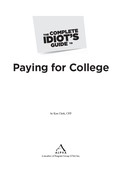Bye-Bye, College Accounts
Just as little kids can get a little sentimental when it’s time to give up their cherished (and raggedy) blanket or stuffed animal, it’s not uncommon for parents to feel unsure about breaking open the college piggy bank. After all, there might be a substantial sum of money in there and it might feel wise to hold onto it in case unforeseen costs pop up.
But, for the sake of your wallet, it’s time to bust open that account. That’s because true college accounts (custodial accounts, Coverdell ESAs, Section 529 plans, and certain trusts, which I’ll discuss in a moment) can hurt your financial aid options as much or more than other assets. Further, most of these accounts have rules that require you to do something else with the money or pay a penalty if it is not used for college.
The one college account you should liquidate last is the one that still has a grandma, a grandpa, an uncle, or an aunt as the owner (such as a Coverdell ESA and Section 529 plan). That’s because accounts owned by extended family members are completely ignored for financial aid purposes under the current rules. With that in mind, you’re far better off to empty your own account and increase your aid eligibility sooner rather than later and then to empty grandma’s account and lower your aid package.
If you have any traditional college accounts, here is the order in which you want to drain them:
• A child’s savings bonds—If you have Series EE or I savings bonds in your child’s name, you’ll definitely need to get rid of these to increase your financial aid eligibility. They count as a child’s asset for financial aid purposes (35 percent contribution rate) and typically have a poor rate of return compared to other assets owned in a child’s name. 

DEFINITION
An asset’s contribution rate is the percentage of its value an owner is expected to use in any given year toward paying for a college education. This rate effectively reduces the amount of financial aid that someone can expect to receive. Currently, when an asset is considered the property of a child, 35 percent of its value is expected to be used in a given year. When it is the property of a parent, 5.64 percent is expected to be used.
• UTMA/UGMA custodial accounts—These accounts, short for the Uniform Transfer to Minors’ Act or the Uniform Gift to Minors’ Act, respectively, count heavily against your financial aid eligibility. Further, they have to be turned over to your child between ages 18 and 25 (depending on your state), so you have no reason to keep these around. Getting rid of them will increase your chances of future aid and reduce the chances your child will come home with a Harley.
• Crummey Trusts and 2503c Minor’s Trust—Although most people who are reading this book are unlikely to have set up one of these old-fashioned education trusts, it’s very possible that grandma or a rich uncle might have. If your child has been named as the beneficiary (recipient) of one of these trusts, you’ll need to begin making some phone calls to figure out how to gain access to it. Because these assets count as heavily against financial aid as a custodial account, there’s nothing worse than receiving less aid and not knowing how to make withdrawals from a trust to compensate for it.
• A parent’s savings bonds—If you have savings bonds in your name, you should get rid of them to take advantage of the tax-free withdrawals allowed to pay for college costs. The reason these are not liquidated at the same time as your child’s savings bonds is that they count against financial aid at a lower rate. Again, they’d typically be liquidated before other assets that also count less against financial aid because savings bonds historically have a much lower average rate of return.
• Coverdell ESAs—Formerly known as the “Education IRA” or “ED-IRA,” these accounts weigh against financial aid at a much lower rate than UGMA/ UTMA custodial accounts. In fact, they weigh exactly the same as a Section 529 plan owned by a parent. But unlike a Section 529 plan, any unused funds in these accounts must be turned over to your child by the time he turns 30 or rolled over to another child.
• Section 529 plan—You almost hate to open the spigot on these accounts because they were so much fun to fill up. But, all the gains built up in this account can be withdrawn tax-free if they’re used for college expenses, as opposed to being taxed and maybe hit with a 10 percent penalty if not used for college. Further, because they do count against financial aid at a rate of 5.64 percent (the same as Coverdell ESAs and other parent-owned assets), they’re much better to get rid of than certain protected assets of the parents. (See Appendix F for a state-by-state list of Section 529 plans.)
..................Content has been hidden....................
You can't read the all page of ebook, please click here login for view all page.
